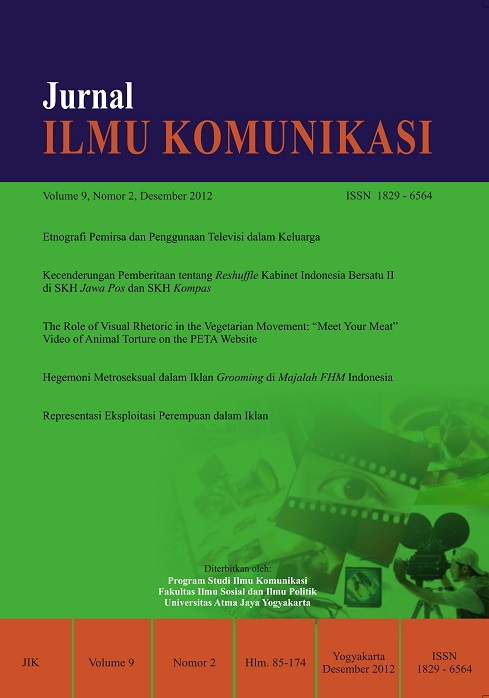Etnografi Pemirsa dan Penggunaan Televisi dalam Keluarga
DOI:
https://doi.org/10.24002/jik.v9i2.167Abstract
Abstract: This research studies the television watching activities of two families in Yogyakarta, which does not intend to measure and find out a specific effect of media usage on family informants but merely gives a description of watching television as a cultural practice. The study was also conducted as a counter-argument from the tradition of media effects research on passive audiences. This research uses ethnographic audience, and the result shows that watching behavior in the family is not monotonous and passive. They do not really give full attention to watch television. Watching television is only one of the existence cultural practices and not the only practices in their daily life.
Abstrak: Di dalam kehidupan sehari-hari, manusia masa kini telah menjadi sedemikian terbiasa dengan kegiatan menonton. Penelitian ini menjelaskan pengalaman menonton yang bertujuan mengeksplorasi penggunaan media televisi dalam rutinitas keseharian keluarga informan. Penelitiaan ini menggunakan etnografi pemirsa terhadap dua keluarga informan yang tinggal di Yogyakarta. Dengan mempertimbangkan aspek-aspek yang sifatnya kontekstual, penggunaan media televisi oleh keluarga informan menunjukkan bahwa menonton televisi merupakan salah satu praktik budaya dan bukan satu-satunya dalam rutinitas keseharian. Keberbedaan pola menonton memperlihatkan juga perilaku menonton yang tidak monoton dan pasif.
Downloads
Published
How to Cite
Issue
Section
License
Jurnal ILMU KOMUNIKASI is an academic journal. As such, it is dedicated to the open exchange of information. For this reason, JIK is freely available to individuals and institutions. Authors who publish in Jurnal ILMU KOMUNIKASI will release their articles under the Creative Commons Attribution (BY) License. This license allows anyone to copy and redistribute the article in any medium or format as well as remix, transform, and build upon the material for any purpose, even commercially as long as they credit the authors for the original creation. For details of the rights authors grants users of their work, see the "human-readable summary" of the license, with a link to the full license. (Note that "you" refers to a user, not an author, in the summary)
 This work is licensed under a Creative Commons Attribution 4.0 International License.
This work is licensed under a Creative Commons Attribution 4.0 International License.














